 |
firm active: 1907-1921 minneapolis, minnesota :: chicago, illinois |
Ye Olde Grindstone
6/30/2007
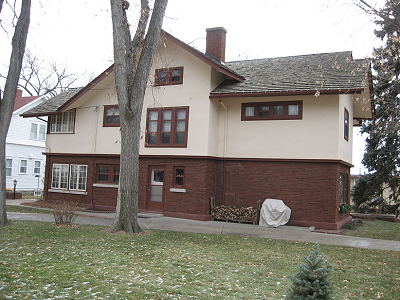 Patrick E. Byrne residence Purcell, Feick and Elmslie Bismarck, North Dakota 1909/1910 Photograph by Richard Kronick, 2007 |
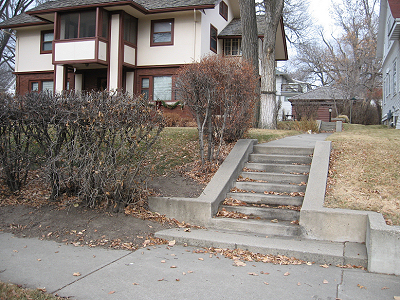 Patrick E. Byrne residence Purcell, Feick and Elmslie Bismarck, North Dakota 1909/1910 Photograph by Richard Kronick, 2007 |
| Clearing the Underbrush. OM! So much of what wants doing takes more time than ever becomes directly visible to the kind readers of the Grind. The Prairie School Exchange, which was designed as a placeholder for things that weren't part of P&E or the Progressives On-Line (both of which are related to my HyperFind software) needs a complete overhaul. Frames in web pages are so past tense, but reference material is not suited to those which are Flash-driven. While the P&E pages serve well enough (even though they look more and more primitive to me), the Progressives part of the site is still mired in the late 1990s, and the database has never been fully hooked up through the web server. I doubt a third of what's in the desktop view of HyperFind makes it through to the web interface. Ideally, I want to sit down and rewrite the HyperFind code to take advantage of the many advances in web technology, thus combining all three areas of Organica into a, eh-hem, organic whole. It's a bit overwhelming to contemplate the vast amount of time and energy required, so I console my frustration with the backlog of contributed materials and incomplete existing pages. | |
| We start with eight images taken earlier this year by Richard Kronick of the Patrick E. Byrne residence (Bismarck, North Dakota 1909). This is the very first commission to carry the Purcell, Feick, & Elmslie title block. Prior to these shots, I had not seen a color view. One sweet discovery is the delicate tracery of sawed wood found in a triangular decorative sawed wood panel tucked up beneath the eave. Given there was funding of this tidbit on the exterior, I can only hope one day for funding for me to get to a place so far off my personal trail as Bismarck to see what's left inside. The Byrne house and the Louis Heitman residence in Helena, Montana, seem sometimes like they might as well be on Mars for the likelihood of my feet ever getting there. | 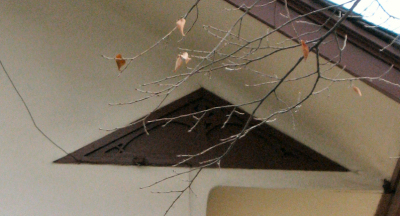 Photograph by Richard Kronick, 2007 |
| Contacts from readers of this column have been uniformly supportive of my continued efforts to sit in my chair, however. Beyond the many images contributed over the past year by John Panning, Tom Shearer, and Richard Kronick, as well as the current owners of several P&E houses, visitors in the flesh here in LA have caused me to open storage boxes whose contents have not seen light in the decade since I moved away from Minnesota or even since the 1980s. I have found things of which I have no recollection, which is astonishing. Has my memory gotten that bad? A wealth of accompanying letters and notes sent along with these documents by those who gave them to me provides me with a context and provenance, but still I have a slightly scary feeling like parts of my mind have slipped away. Something of this sense of evaporation came up, too, during my recent teaching stint at UCLA, where I realized I had actually forgotten cold the name of the Minnesota State Arts Commission. All this has moved me to reacquaint myself with what I do have for review--and share that process here. | |
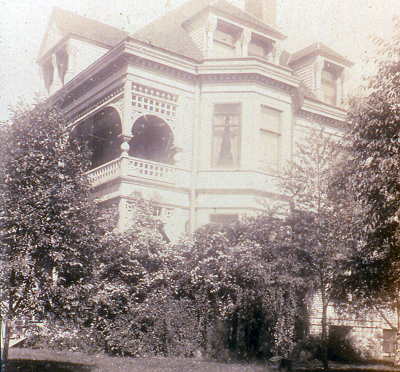 |
 Library (Books, books, books everywhere) Photograph by William Gray Purcell W. C. Gray residence #2 Oak Park, Illinois circa 1890s Source: William Gray Purcell Papers William Cunningham Gray residence #2 319 N. Kenilworth [demolished] Oak Park, Illinois circa 1890 Source: William Gray Purcell Papers |
| A missing piece of paper surfaced during recent excavations to kick off completion of the "Review of Gebhard Thesis" manuscript written by Purcell in the 1950s. This is really Purcell's autobiography, written in the third person to nurse along his hopes for a complete biographical treatment out of the doctoral dissertation being prepared on the firm by David Gebhard. The new section now up is William Gray Purcell - Part I., where he clearly states the critical nature of his childhood experiences at Island Lamp Camp to his philosophical development and the fundamental importance of having been raised by his grandparents, particularly the literary exposure. Switching between his effort at third person and the urge to quote himself directly (with the occasional slip of the tense in between), Purcell recounts the two most significant adventures of his youth, a trip to the gold fields of Alaska in 1900, and the journey to Kowaliga, Alabama, a year later to offer assistance with what we would now call low cost housing for an African-American community. | |
 Sketch for a cottage William Gray Purcell Community planning for William Benson Kowaliga, Alabama 1901 Source: William Gray Purcell Papers It doesn't matter this was never built. The whole place was later flooded out with the creation of Lake Martin. Although Benson's home escaped the floodwaters, it burned shortly thereafter. A fine account of William Benson's important but now submerged achievements for his community can be found here. |
Like the earlier trip to Alaska, the Kowaliga experience arose from the travels of his grandfather. W. C. Gray did a series of pieces in The Interior exposing the horrors of sharecropping after traveling through the South. There he had met William Benson, an educated African-American who wanted to build housing and other town facilities for the local community. Dr. Gray volunteered the services of his grandson as an architect and Purcell duly ventured down to see what could be done. After spending the first night hidden under a bed to avoid getting swept up by a lynch mob (being caught as a white Yankee troublemaker staying with Benson), Purcell did some surveying and prepared some sketches. The altruistic program of what amounted to Purcell's first client was fundamentally impossible to realize under the circumstances, but the experience was an eye opener to the young architect-in-training. Nearly a century later the African-American congregation struggling to restore the Stewart Memorial Church in Minneapolis took great heart in this story, as well as those concerning the Gray family's participation in the underground railroad in the years prior to the Civil War. I was a little less pleased to hear a nationally prominent historian get up in front of this assembly and plagiarize verbatim my own writing on these events as his own, without the slightest shame. |
 K. Paul Carson, Jr. residence William Gray Purcell, architect Edina, Minnesota 1941 That's Mary Carson sitting on the terrace, ca. 1950s. |
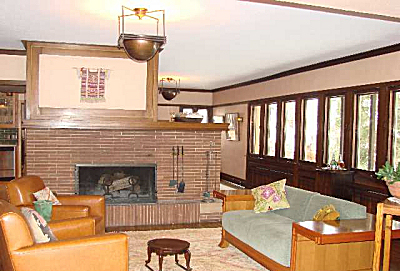 Living room, 2007 Oscar Owre residence Purcell, Feick, and Elmslie Minneapolis, Minnesota 1911 Somewhere underneath that paint above the fireplace there may still remain a mural painting by Charles S. Chapman. The Owres never liked it, apparently, and it was soon painted over. Additional coats since may have actually preserved the work. Cotton swab, anyone? |
| Other news.
I notice that both P&E books issued in the past year have been remaindered.
I saw copies of the Dixie Legler tome piled up for $8 each, and the Gebhard
volume shows up on eBay regularly for about the same amount. The work of the
firm, however, continues to rise in cost, even with the occasional markdown
on the way to closing. The Oscar Owre house in
Minneapolis is currently on the market for $1,499,000, but that price has
dropped $100,000 since the listing went up. While not directly a P&E house,
the
K. Paul Carson,
Jr. residence in nearby
Edina has sold for $620,000, off a listed price of $679,000. I remember Paul
Carson walking me around the property explaining the conservation easement
of three and a half acres of the five acre parcel purchased just before
World War II. No doubt that had something to do with the adjustment of
price; that, and the huge revivalist McMansions that have effulged from the
nearby ridge, looming down in all their overwrought scale over this once
tucked away prairie suburban ranch house. Since P&E had designed an unbuilt house for his father, the newly wed Carson and his wife Mary contacted Purcell. He favored them with the plans for the house now on 6001 Pine Grove Lane as a wedding gift. Drafted by Fred Strauel, the plan was realized in phases over decades. The last main section was raised only in the very early 1990s, a studio extension with large thermal plate windows opening onto the surrounding woods, warmed by a pot bellied stove. I see that all the little leaded glass panels installed in the living room windows to commemorate family events over the years have been removed, leaving the new owner to start over with giving the house a family history. Paul said that was going to happen, though I wonder if they will ever have the meaning loose in the world that they had in the windows of this house. A historical note: down on the acreage now protected by the easement there are two pine trees named Bill and Cecily, "volunteers" who took up residence shortly after the house was built. 'Til next time. |
|
6/17/2007
The past six weeks have been an example of
"life is what happens while you make other plans." We can have a
financial recap best summarized with the question, "How can you receive
more money than you've had in years and have less at the same time?" I
suppose because everywhere there has grown a deficit. In nearly every
direction there seems to rise up a debt, unmet obligation, or deferred
expense. And some serious ones for my research are still out there,
rustling in the Prairie brush, like an unpaid bill for both photocopies
at NAA and the researcher who did the work. How do I survive with this
much involuntary shame? For the first time in a long while, however, the
ISP that serves this site is paid in full, along with the power and the
phone line that also drive delivery of these pages to the hundreds of serious users
(10 or more page views) who cruise freely through every month. That took
$400. At least I have been able to buy groceries, a bit of a novel
change from the past few years. Imagine, eating protein on a daily
basis. Now, overlay the day job with the events
since the last Grind. I work near Griffith Park. While their own house in
the Hollywood Hills is under construction, the people whose employment
kindly rescued me from potential homelessness and starvation, never mind
running out of cat litter, are staying in a 1925 Rudolph Schindler remodel that
butts up against the park edge. In case you missed it, 1,000 acres of the
park were consumed and the conflagration came within fifty feet of this
significant house. The fire department camped on the street for three nights
after everyone in the neighborhood was evacuated. Knowing the dog was safe
because I brought him back down to the office, I faulted myself later for
not having the courage to suggest taking the Hiroshige woodblock prints off
the walls while I watched on television as walls of flame surged down the
hillside. These heavily populated hills are filled with houses by Schindler,
Neutra, the Wrights (Lloyd, Eric and Frank), and a host of other important architects, and think of what
might have happened by recollecting all the houses by Julia Morgan and
Bernard Maybeck lost only a few years ago in a similar event in the hills
behind Berkeley. Blessedly, the heroic efforts of LAFD were triumphant and
none of the multi-million dollar houses, or the Observatory, were damaged.
But you can imagine what all that did, and the damage to the park is still
doing, to traffic. Everyone got to share in the moment. Of course, I subverted the syllabus
into a troll through Sullivan and P&E by visiting the World's Columbian
Exposition. But I'm telling you, I haven't taught since I was at
Taliesin, and these were graduate students, to boot. I asked, "Any
questions?" and was there for another half hour discussing reasons why
the facade of 12th century St. Gilles du Gard bears a startling
resemblance to Trinity Church. That's why they call it historical
revivalism, folks. I like to think there are now one or two people in
the ranks of the ASID student chapter who question eclecticism, but
maybe I kid myself.
And I did make the point about one door
for democracy, and three doors divvied up between nobility and everyone
else. Democracy corrupted by the lusty hedonism of capital, of course,
means you can come inside only if you can pay. One door is less
expensive to maintain, a nice dovetail. And no, you don't get to vote on
how much it costs. That is a matter for the private sector. Wherever
that is in a world of public commerce. Well, naturally, just look for
the back door. Have I been reading Purcell or what?
A bright spot
in all this was the visit of my good writer/editor/musician friend Richard
Kronick from Minnesota. Dick has done more than anyone over the years to encourage me
to keep neurons active for writing the P&E book. I took a day off to
talk about that, and other things, with him. Although he had the poor
fortune to be here on a Monday when most things of interest are
shuttered,
I did manage to get him through the Greene & Greene neighborhood of
Arroyo Seco in Pasadena and, through a fortuitous chance, into the
otherwise closed Rudolph Schindler house in Hollywood. Since Dick has a
mystical bent akin to mine own, we also touched down in Bodhi Tree
Bookstore. One last opportunity arose for refreshment at nearby Elixir,
a wonderful teahouse on Melrose with a hidden Zen garden that has been
forced out of business by a merchant in Beverly Hills who wanted to expand and simply offered the landlord double the amount of
rent. Yes, it is the City of Angels, but they don't tell you many of
them are the ones who sided with Lucifer. The rent already being
outrageous, well, out, out damned pleasant refuge. The house and garden
may still be there in some form, but the great crew of people who were the spirit of
the elixir are unemployed. A favored escape from urban insanity
that I had treasured is now gone. And that is a potent loss
to my wellness, a real sign to me LA is less of a place I want to be.
Dick enjoys ferreting out the organic
riffs that percolate through the right writers, and is constantly
sending me delicious snippets of his finds. He makes me think about the
ways other people perceive architecture and express their understanding.
Usually something will tumble out of me in response--sometimes no doubt
to Dick's disappointment, because he places a strong emphasis on the
literature and, sadly, being so often the man behind the curtain, I
don't follow the action on the stage as much as I should. Dick shares a
moment of Claude Bragdon: "We are all of us participators in a
world of concrete music, geometry and number ... so mathematically
related and coordinated that our pygmy bodies, equally with the
farthest star, vibrate to the music of the spheres. There is a
Beautiful Necessity [emphasis in the original] which rules the world,
which is a law of nature and equally a law of art, for art is
idealized creation: nature carried to a higher power by reason of its
passage through a human consciousness... . Art therefore in one of its
aspects is the weaving of a pattern, the communication of an order and
a method ... no masterpiece was ever created by the conscious
following to set rules, for the true artist works unconsciously,
instinctively ... an analysis of any masterpiece reveals the fact that
its author ... has 'followed the rules without knowing them.' " and I chuffed back: In the world that has of late wholly
claimed my thoughts, I see that the notion of an individual creating
anything is an illusion. There is no separate individual, so no
separate act of creation is possible. The view that there is 'someone
creating something' is an inverted perspective. The whole is
expressing a single movement through a complete cycle of energy ("the
Great Life"). Our poor, limited, fragmented comprehension, rooted in
the falsehood of duality, forms imaginary constructs with an
incomplete (linear) set of "elements" by which we define the actions
of a 'process.' It's all a conversation to amuse ourselves. The
universe is busy creating itself, regardless of whether we are awake
or asleep. The ephemeral churnings of our minds are merely sparks
created by the friction of our efforts to find a way to pretend to be
in charge. Dick probably deserves better from me
for his efforts. Note to self: Get out of cynical mood. Share the joy
offered.
On a brighter note... Yes, more
gifting from Tom Shearer...isn't this great?! Now, the coup de grace. A week after that
refreshing visit, I caught The Cold From Hell, and was black-holed into bed
for five days. So everything ELSE could fall behind, huh? Still in one thing
leads to another mode, during this lengthy hiatus from updating Organica I
spent an entire weekend to help along a Frank
Lloyd Wright media project that might possibly turn into something of major
interest. I confess, it was a heady prospect dangled before me to meet Brad
Pitt and Ridley Scott, both of whom have long been interested in FLLW; but
of course I was merely anonymously doctoring a movie treatment--albeit one
for which the producer has a license from the FLLW Foundation, a fact that
my connections there were able to verify before I spent the energy. No Brad
Pitt sighting for me, alas, though I did otherwise get to see the backside
of a sweet little Modern artist studio he's putting up on his Los Feliz
estate. He's got good clean taste in architecture, apparently; hey, Angelina
took him to Fallingwater for his birthday. If anything comes of the effort,
as unlikely as that seems, I will update when news warrants. {Don't you
think it is a great day when I can put Brad Pitt into a blog on Purcell and
Elmslie?} That involvement entailed a trip to the Getty Research Institute to consult the
Frank Lloyd Wright Archives microfiche, for whose immediate vicinity I
always give thanks. I was also motivated up to the Beige Acropolis by email requests for
research information. A class at St. Thomas College in Minnesota regularly
focuses on P&E and uses Organica as a resource. While one student was
interested in tracking down more on Marion Alice Parker,
another was after anything else known about Harry
Franklin Baker. Baker was a Minneapolis landscape designer who worked
with P&E, but little (known to me, anyway) has survived beyond what is
already available on the site. The indexes to the FLLW correspondence,
comprised of numerous thick volumes, are a marvel of detail and
thoroughness that conceal a number of unidentified treasures. I'd never thought to look for anything there from Miller, but
told my inquiring student researcher that I would. Lo! Behold
one penny
postcard, dated March 29, 1934. Miller says, and sympathy arises: "I too have been a strayer from the beaten
path and alternately persecuted and neglected by the world's theological
officialdom (American Academics for the Advancement of Material and
Literal-minded Scientists), fearful of losing their livings by not tracting
to University trustees or directors of big business." In a comment for which I sympathize in the
metaphor, but only the Minneapolis police arrested Frank Lloyd Wright and
the other guy had the real Inquisition on his back, he then says: "You might be the reincarnation of Galileo! But he does continue in a vein familiar to
those who mine beneath the surface of the Prairie School: "In the Rig Veda, wherein Brahma is not
even mentioned...but the "Golden Egg" and Prajnapati are, and from
the latter emanates all the hierarchies of "Creators." Hinted at or implied
in the Rig Veda are the Monad or point of First Causes, THAT, but 'the
Logos, which is the expression of THAT is passed over in silence. In its
turn...the point within the circle was not yet the architect but the cause
of that architect...' Does that sound like Ouspensky? (But it's
not)." Our good Caravan fellow Dick Kronick will no doubt be pleased to see
the overt reference to Ouspensky and quotation from a Theosophical text, and
I was surprised to know that Miller worked for Wright before responding to
George Elmslie's call for plantings at his cousin's house. Curiously, he
retired to Beaumont, California, only a few miles up the highway from where
Purcell was bedridden with tuberculosis at the Pottenger Sanatorium in
Banning at the same time. Quite the cluster of these P&E folks wound up near
Purcell in southern California, from client Charles R. Crane in Palm Springs
to Team members Marion Alice Parker and Lawrence Clapp in coastal Laguna
Beach, and Douglas
Donaldson, from the Minneapolis Handicraft Guild, in Hollywood. You've Got To Be Kidding Me Department.
I have vented here before about the benighted destruction of the main
banking room wall at the
Merchants National Bank in Winona for the sake of having
space to let someone's ego to expand into the building next door. Last week
I received an email request for use of one of Tom Shearer's images of the
bank's leaded glass, and a brief exchange came about from comments made as I
referred the individual onward. There was some fantasy going around Winona
that the mural from the wall had been saved and deposited at the Northwest
Architectural Archives. The director of the local county historical society--a
nice guy whom I met years ago while curating the P&E galleries for the
Minnesota 1900 exhibition--was said to be trying to get it back to hang in a new museum space proposed
for an existing parking lot. Furthermore, this information was related to me
as being direct from some present bank honcho. Back in the 1990s a beaming
bank vice president explained to me that the mural was "destroyed from water
damage and the wall accordingly had to come down..." (anyone there ever hear
of restoration?). Plus someone would have very likely mentioned to me
if the tatters of the mural were lodged, or lobbed, at the University of
Minnesota, but you know how sometimes the heart wants to take that great
leap and believe something just because it would be better if it were so.
Well, of course, some research had to be pursued immediately. Asking the
right person, like a friend of someone who was with the bank for 45 years,
makes it clear that nothing so wishful could be further from the truth.
Departed, lost, gone forever, the permanent loss of this irreplaceable piece
of heritage is impeccably confirmed.
Merchants National Bank
Main banking room, 1914
Every time I see this banking room image I am
reminded of the man who sold me my abovementioned car in 1998. "Take a long look
at it now. It's never going to look this good again." How many people, I wonder, think that
there's a box put by somewhere with everything like that which should have
been saved (preferably on the original wall, in this case), when in fact the
only things still there are the guilty consciences of the ignorant fools
whose throes of cultural clumsiness destroyed better than they, or anyone in their
community, will ever have again? Eventually, I think someone will be able to
organize a "Dancing on Their Graves" tour. We can all go to the final
resting places of those faulty stewards, as mad as Denethor in Lord of
the Rings ("Bring wood and oil..." he commands from the gutter of his soul,
brandishing a flaming torch), whose deficient spirits brought down the
Babson house, the Edison Shops, the Madison bank, the Decker house, and so
on. We can play a little ragtime and stomp our feet in the appropriate
places, expectorating as moved. Fun Stuff. If you came in through
the front door, you may have noticed that
a Cluster Map has been added to
the main page. This neat little free service allows a graphical representation of
the geographical locations of people who visit the site. It's been up for
all of five days, but already the geographical reach of the site is showing
up. It'll be neat to see this in a year, because the log analyzer reports
visitors from over 70 countries since 2005. Not bad business for a firm that
closed in 1921! And whoever did this map has a great sense of place. They
put the shadow of Atlantis right where it is supposed to be, where
apparently someone likes the Prairie School. With that, I'll
try to get back on a timely schedule as things Grind on.

Bank draft form
Exchange State Bank
Grand Meadow, Minnesota 1910
Source: William Gray Purcell Papers
Pass the
Ammunition. Yes, it's been a while.
I tell all, but you can choose to look at the pretty pictures from Tom
Shearer and skip my personal gargling if you want. But kindly interested
people email and ask how's it going, why haven't I put up anything new for
so long, etc., so I thought I'd cover the whole shebang. Before this lengthy
catchup/catchall commences, feast your eyes on this exquisite achievement in
photography (apparent to anyone who has ever tried to take a picture of that
space):
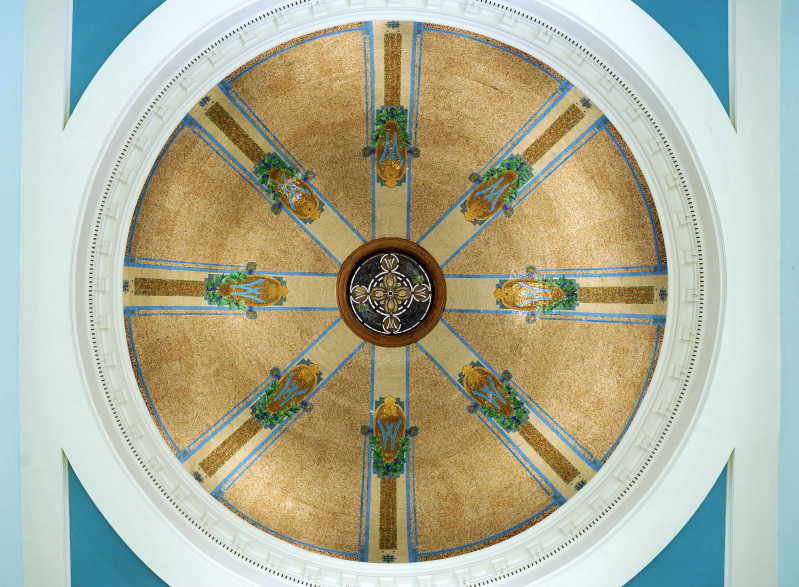
Rotunda mosaic
Watkins Medical Company Offices
George Washington Maher, architect
Winona, Minnesota
Photograph by Tom Shearer, 2007

Frieze panel, probably from Midland
Terra-Cotta Company catalog
Detroit Lakes Public Library
Detroit Lakes, Minnesota
Photograph by Tom Shearer, 2007
Editor's Note: Readers
disinterested in candor about real life may wish to skip to
this. Someone who obviously doesn't
read any blogs said about the Grind, "Mark, why would you want to be so
vulnerable to strangers?" I replied, "This is my experience. Am I
supposed to wait to be dead before I talk about happened to me on this
earth?" Write from what you know, I've been told time and again. So,
this is what I can acknowledge as the moment. The rejoinder was, "Well,
Mark, you are quaint for sure." What does that mean, anyway? Not quite
interesting enough to qualify as eccentric?
Then the twelve year old car, which has barely had an an annual oil change since the
economic crash of 9/11, decided it was done, and that sucked up another
$1500--in major bi-weekly chunks to cover the volunteered use of someone
else's Amex card. Thankfully, the long suffering auto shuddered to a
stop close by a decent garage. Boy, did I luck out. Did I mention I owed
my doctor money? Try having even a minor stroke with no health
insurance. Real nice guy, he sees me whether I have cash or not, and
gives me samples of the necessary drugs I cannot afford, but the office
visits still rack up a tote. Oh, and a tooth broke, never mind the three
empty molar spaces waiting, a bit like Wendy for Peter Pan, to have
$14,000 in implants. And, screw it, I finally threw out the wobbly,
carpet gouging desk chair salvaged from the dumpster and bought one on
half-price clearance at Staples ($49). How rude to think of sitting here
without a backache.
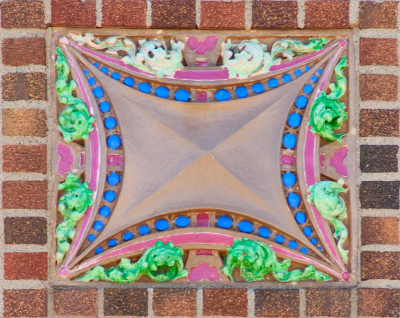
A Prairie dose of LSD-25
Catalog module, possibly Midland Terra-Cotta Company
Former bank building
Aitkin, Minnesota
Photograph by Tom Shearer, 2007
When I started working
again, the setup was designed to provide with enough part-time hours to
pay the bills and let me concentrate, threadbare existence
notwithstanding, on writing. As if. That lasted about two months.
Treading water doesn't really get you anywhere, it turns out. Then the
nature of having two hands present in an architectural practice took
over. I started working overtime to get a project out and, if you know
anything about small architectural offices, by the end of that first
stretch the available motions are become indispensable as a general
rule. Batter up. Don't get me wrong, I am grateful for the
opportunity. But I get home after the average ten hour day
now--including an hour plus of commute, depending on rush traffic and
surrounding events--and I am drained. This 50-something carcass sinks
into my new chair and stares blankly at the computer screen. I am
supposed to be doing what here? I know there are those of you who
read this out there who are ALSO raising children, so forgive my bleats
in minor key. (What it is with me and puns today?)

The big picture, threatening the little pictures

Iconic Griffith Park Observatory, newly restored and expanded, in
peril
Next up, one
of my dearest friends, an art history professor, went on hegira in Asia.
While she ran an arc through Singapore, Vietnam, China, and Japan, I
covered an installment of her classes at UCLA. Forgive me, but I just
haven't thought all that much about H. H. Richardson, Burnham & Root,
the City Beautiful, etc., for a long while. Getting back into all that
and preparing three Powerpoint presentations took most of a week's "free
time." If I felt exhausted when I started, I fairly staggered to the
parking ramp after three hours of class--espresso during break not
withstanding.


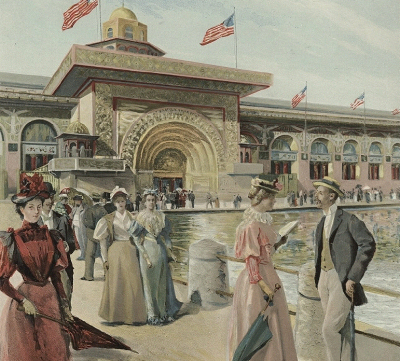
The Golden Door, Transportation
Building
Louis Sullivan, architect
World's Columbian Exposition, 1893
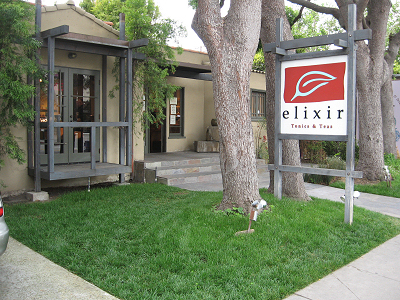
Elixir, a sanctuary of the spirit now
departed
Photograph courtesy Richard Kronick
Claude Bragdon: The Beautiful Necessity, pages 29-30
Still obsessing after individual meaning, we all remain beautiful
necessities.
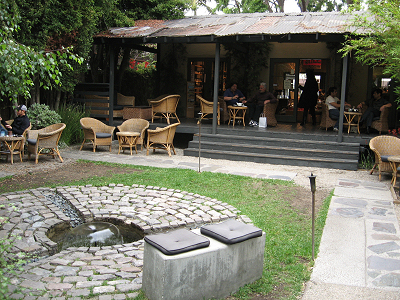
The Zen surprise off busy Melrose, lost like Atlantis to LA greed
Photograph courtesy Richard Kronick
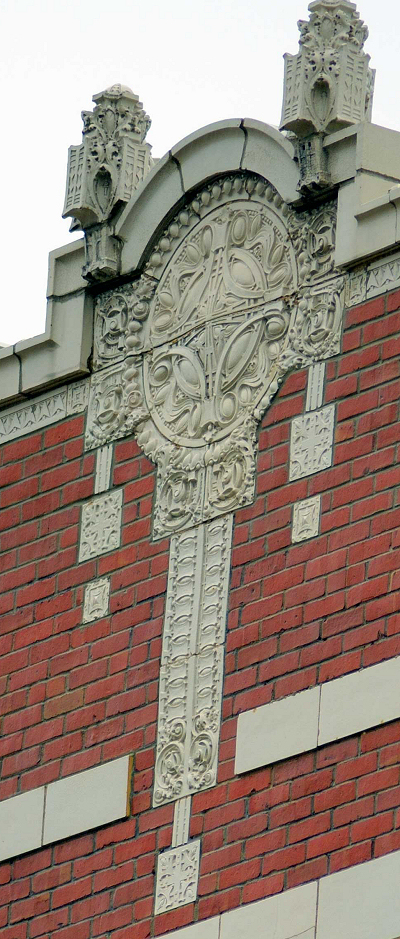
Detail, cornice
Frieze panels from Midland Terra-Cotta Company
(Catalog, plate 47)
Building currently known as the Powers Hotel
Fargo, North Dakota
Photograph by Tom Shearer, 2007
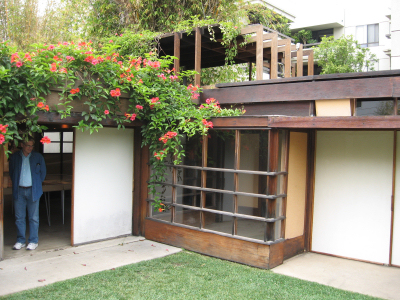
Rudolph Schindler's house on King's Road, with your host looking out
Hollywood, California 1922
Photograph courtesy Richard Kronick
This is the Lake Place of Southern California, and should be on
everyone's list of required places to see. Now run as an exhibition
gallery called the
MAK Center, saved by the Austrians!

Detail of reprint cover
Introduction by Christopher Vernon
University of Massachusetts Press
Instead, I suggested that the student might want to look at
William
[Wilhelm] Miller (18691938), the landscape architect for the
Amy Hamilton
Hunter residence (Flossmoor, Illinois 1916). Miller produced a
publication of seminal importance titled The Prairie Spirit in
Landscape Gardening. Down under Caravan member Christopher Vernon
wrote, if I may say so, a superb introduction to the republication of this essential text in
2002; a preview is available at Google Books.
I have earlier
noted the elusive nature of my communication with Christopher.
His estimable work is a great contribution to the study of Prairie
landscaping. Like Griffin, he went to Australia, but the distance seems
only to have strengthened his perspective. Indeed, it was only because
of his research that your humble servant came to realize who Miller was
to P&E, and also, now evidenced, to Frank Lloyd Wright. G'day,
Christopher.
![]()
To set the mood for the following:
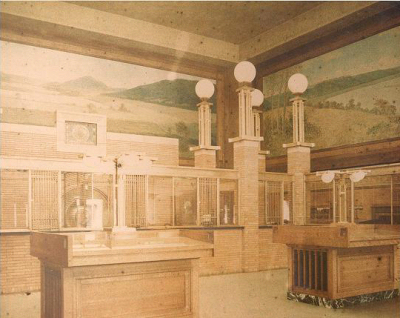
Purcell, Feick, and Elmslie
Winona, Minnesota 1912
Autochrome Lumiere, by William Gray Purcell
Now for something cooler...

Dot sizes:
![]() = 1,000+
= 1,000+
![]() = 100 - 999
= 100 - 999
![]() = 10 - 99
= 10 - 99
![]() = 1 - 9 visits
= 1 - 9 visits![]() research courtesy mark hammons
research courtesy mark hammons